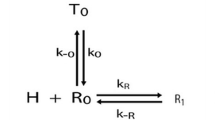Summary
The status of the matrix theory of antigen presentation to lymphocyte receptors is discussed in the light of recent and current work. The theory gives an adequate account of the T-B lymphocyte cooperation, the role of macrophages in antigen potentiation, the special immunogenic capacity of polymeric antigens and the central role of antibody in initiating tolerance. By extension it accounts also for the synergistic role of red cells and other membranes in potentiating lymphocyte transformation by PHA. It does not account adequately for signal discrimination. The importance of bridging in anti-immunoglobulin experiments, and studies on control by anti-immunoglobulin complexes and by antigen-antibody complexes indicate that factors other than net antigen concentration play an important part in the control of events at the lymphocyte surface. These factors are provisionally identified as topographical, but no comprehensive theory of receptor binding, pattern or density is yet formulated. It appears likely that comparable toporaphical factors will be important in other kinds of cell interactions and in the control of morphogenesis.
Similar content being viewed by others
References
Warner, N. L. 1971. Surface immunoglobulins on lymphoid cells. Contemp. Top. Immunobiol. 1: in press.
Greaves, M. F., and N. M. Hogg. 1971. Immunoglobulin determinants on the surface of T and B lymphocytes in mice. Progress in Immun., 1: (in press).
Greaves, M. F. 1971. The expression of immunoglobulin determinants on the surface of antigen binding lymphoid cells in mice. I. An analysis of light and heavy chain restrictions on individual cells. Europ. J. Immun. 1: 186–194.
Wigzell, H., and B. Andersson. 1969. Cell separation on antigen-coated columns. Elimination of high-rate antibody-forming cells and immunological memory cells. J. Exp. Med. 129: 23–36.
Ada, G. L., P. Byrt, T. Mandel, and N. Warner. 1970. A specific reaction between antigen labelled with radioactive iodine and lymphocyte-like cells from normal, tolerant, and immunised mice or rats. In: J. Sterzl and I. Riha (Eds.)Developmental Aspects of Antibody Formation and Structure. Academia Publ. House, Prague, pp. 503–516.
Humphrey, J. H., and H. U. Keller. 1970. Some evidence for specific interaction between immunologically competent cells and antigens. In: J. Sterzl and I. Riha (Eds.),Developmental Aspects of Antibody Formation and Structure. Academic Publ. House, Prague, pp. 485–502.
Siskind, G. W., and B. Benacerraf. 1969. Cell selection by antigen in the immune response. Advances Immun. 10: 1–50.
Mitchison, N. A. 1970. Cellular and molecular recognition mechanism prior to the immune response. In: A. Studer and H. Cottier (Eds.),Handbuch der Allgemeinen Pathologie. Springer-Verlag, Berlin, pp. 237–249.
Bell, G. I. 1970. Mathematical model of clonal selection and antibody production. Nature (London) 228: 739–744.
Mitchison, N. A. 1971. Cell cooperation in the immune response: the hypothesis of an antigen presentation mechanism. Immunopathology 6: 52–63.
Mitchison, N. A. 1968. Recognition of antigen. Symp. Int. Soc. Cell Biol. 7: 29–42.
Möller, G. 1970. Immunologic triggering. Cell. Immunol. 1: 573–582.
Gershon, R. K., and K. Kondo. 1970. Cell interactions in the induction of tolerance: the role of thymic lymphocytes. Immunology 18: 723–737.
Yachnin, S., L. W. Allen, J. M. Baron, and R. H. Svenson. 1971. The potentiation of phytohaemagglutinin-induced lymphocyte transformation by cell-cell interaction; implications for the matrix theory of cellular synergy in the immune response. Cell. Immunol. in press.
Fanger, M. W., D. A. Hart, V. J. Wells, and A. Nisonoff. 1970. Requirement for cross-linkage in the stimulation of transformation of rabbit peripheral lymphocytes by antiglobulin reagents. J. Immun. 105: 1484–1492.
Raff, M. C. 1970. Two distinct populations of peripheral lymphocytes in mice distinguishable by immunofluorescence. Immunology 19: 637–650.
Taylor, R. B.—unpublished data.
Raff, M. C., and S. de Petris—unpublished data.
Mitchison, N. A. 1967. Antigen recognition responsible for the inductionin vitro of the secondary response.Cold Spring Harbor Sympos. Quant. Biol. 32: 431–439.
Takahashi, T. 1971. In: Int. Symp. on Relationships between tumor antigens and histocompability systems. Transplantation Proc. in press.
Sell, S., J. A. Lowe, and P. G. H. Gell. 1970. Studies on rabbit lymphocytesin vitro. XII. Augmentation of anti-allotype blast transformation by a second anti-allotypic serum directed against the primary stimulating anti-allotypic serum (Piggy-back effect). J. Immun. 104: 114–118.
Britton, S., N. A. Mitchison, and K. Rajewsky. 1971. The carrier effect in the secondary response to hapten-protein conjugates. IV. Uptake of antigenin vitro and failure to obtain cooperative inductionin vitro. Europ. J. Immun. 1: 65–68.
Greaves, M. F., and Mitchison, N. A.—unpublished data.
Mitchison, N. A. 1971. The carrier effect in the secondary response to hapten-protein conjugates. II. Cellular cooperation. Europ. J. Immun. 1: 18–27.
Greaves, M. F., and N. M. Hogg. 1971. Antigen binding sites on mouse lymphoi cells. In: O. Mäkelä, Anne M. Cross and T. U. Kosunen (Eds.),Cell Interactions in Immune Responses. Academic Press, New York, pp. 145–155.
Mitchison, N. A. 1969. Unmasking of cell-associated foreign antigens during incubation of lymphoid cells. Israel J. Med. Sci. 5: 230–234.
Boak, J. L., and Mitchison, N. A. 1969. Stimulation of lymphocytes by direct exposure to antigenin vitro. Transpl. Proc. 1: 539–542.
Hellström, K. E. 1970. In: R. T. Smith and M. Landy (Eds.),Immune Surveillance. Academic Press, New York.
McCullagh, P. J. 1970. The transfer of immunological competence to rats tolerant of sheep erythrocytes with lymphocytes from normal rats. Aust. J. Exp. Biol. Med. Sci. 48: 351–368.
Gershon, R. K., and K. Kondo. 1971. Immunology—in press.
McCullagh, P. J.—personal communication.
Feldmann, F. 1971. Induction of immunity and tolerance to the dinitrophenyl determinantin vitro. Nature New Biology 231: 21–23.
Plotz, P. 1971. The use of affinity labelling in the search for antigen recognition sites. In: O. Mäkelä, Anne M. Cross and T. U. Kosunen (Eds.),Cell Interactions in Immune Responses. Academic Press, New York, pp. 171–179.
Boyse, E. A. 1970. In: R. T. Smith, and M. Landy (Eds.),Immune Surveillance. Academic Press, New York.
Author information
Authors and Affiliations
Rights and permissions
About this article
Cite this article
Mitchison, N.A. Control of the immune response by events at the lymphocyte surface. In Vitro 7, 88–94 (1971). https://doi.org/10.1007/BF02628267
Issue Date:
DOI: https://doi.org/10.1007/BF02628267




